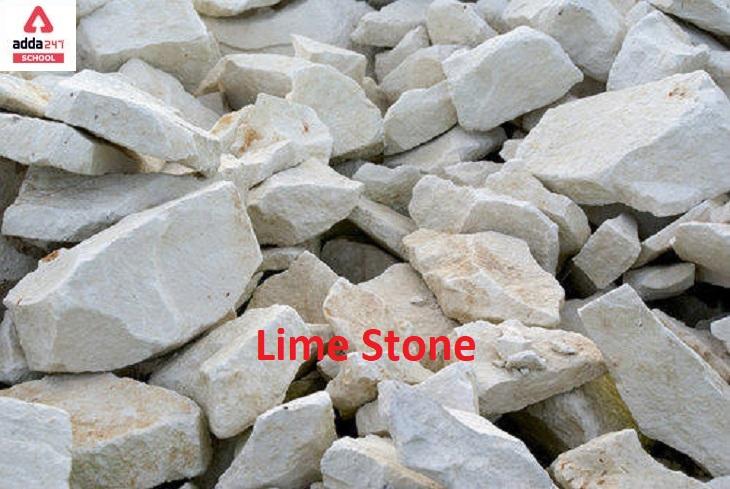Table of Contents
Lime Stone
Limestone is hard, a sedimentary rock that is composed of calcium carbonate also known as dolomite. It is generally used in making cement. The texture of limestone is clastic or non-clastic (depending on the type of limestone). It is usually yellow, white or grey. Limestone is formed when minerals like Calcite and aragonite are precipitated out from the water in which calcium is dissolved. The chemical formula of limestone is CaCO3 or Calcium carbonate. The process of formation of limestone can be biological and non-biological. The biological processes are carried out by the accumulation of corals and shells. There are numerous uses of limestone such as material building, production of cement/concrete, bases of roads, toothpaste, paints, etc.
Limestone Formula
Limestone is made of three major minerals calcite, dolomite, and aragonite. Formula of Limestone is CaCO3. It is formed basically on the seafloor because it is rich in the necessary mineral Calcium Carbonates. Limestone is a hard sedimentary rock that is made up of bryozoa, corals, shells, microscopic algae, and crinoids. These dead remaining marine animals may have contributed to the making of sedimentary rocks. These organisms help in the construction of Shells and skeletons from the Calcium carbonate found in the sea. The fossils like coccoliths and foraminifera contribute to the formation of limestone. Formula of Limestone is CaCO3.
Limestone Chemical Name
The chemical name for limestone is calcium carbonate. Its chemical formula is CaCO3, which indicates that it is composed of one calcium (Ca) atom, one carbon (C) atom, and three oxygen (O) atoms bonded together.
Chemical Formula of Limestone with Reaction
CaCO3 + H2O. + CO2 ͢ Ca 2+ + 2HCO3–
The increase in temperature and decrease in pressure reduces the amount of CO2 and precipitation of CaCO3 dissolved in the solution.
Classification of Limestone
There are two major classifications of limestone, the folk, and the Dunham. These are used to identify the types of carbonate rocks or Limestones.
- folk classification – The folk classification is developed by Robert L. Folk. It emphasizes the composition of grains and the interstitial material of limestone. According to composition, there are three main components of limestone
– Allochems or grains
– Matrix or Micrite
– cement of Sparite
But, according to the folk, the limestone is divided into two parts.
– Grains
– cement
The folk classification helps to determine the additives easily in every pattern.
- Dunham Classification– Robert J. Dunham came with his publication of limestone in 1962. He divided the carbonate rocks into four groups based on relative proportions of coarser clastic particles. The Dunham Classification is more reliable because the facts it has stated till now are true km the basis of texture.
Limestone Meaning
There are different types of Limestone and each with different properties like appearance, composition, and physical properties. Some of the types are listed below.
- Chalk – It is a fine-grained, limestone that is formed by the calcium carbonate skeletal remaining of marine organisms. It is light-colored, the texture is fine and smooth and it can be crushed easily. Chalks are generally used to write on the blackboard.
- Crystalline Limestone – The crystalline limestone is formed when the calcite rock is heated and applied to pressure. This process is called metamorphism. The Crystalline Limestone is called marble in proper form.
- Dolomitic Limestone- It is a calcite composed rock. Dolomite is formed when the calcite in CaCO3 is modified by the magnesium-rich groundwater. The process of conversion of calcite into dolomite is called dolomitization.
Limestone Uses
There are so many uses for limestone. limestone is a sedimentary rock but its properties make it more versatile. Some of the uses of limestone are listed below.
- Agriculture – limestone is a deposit of calcium carbonate, which makes it highly useful in the agriculture sector. The limestone is crushed into small pieces and used to produce different grades of limestone. The product made by this process is called Agricultural lime or Aglime. The Aglime is used to neutralize the acidity of the soil.
- Industrial uses- limestone is used in paper, rubber, paint, textile, and plastic industries. Limestone removes impurities, therefore it is used in the steel industry.
- Filler- Limestones are used as fillers in many industries and also in sewage disposal systems.
- water treatment – By-products of limestone, which is lime, are used to absorb impurities and pollutants from water and also neutralize the acidity of water
- It is used to manufacture cement, slaked lime, and quick time.
- Used in the production of road bases and asphalt concrete bases.
- used in glassmaking
- used to make toothpaste, paper, paint, plastic, and tiles.
- used in underground coal mines to suppress Methane explosions
- used in sculpture and architecture
- limestone formation due to the biological processes form huge petroleum reservoirs.
Related Post:
- Cannizzaro Reaction – Definition, Examples, Mechanism
- Lifecycle Of Silkworm- Diagram, Drawing, Project
- Scattering Of Light- Examples, Definition, Discovery, Prism
- Highest Dam In India
- Which Is The Longest Dam In India
- Aufbau Principle Definition, Formula, Example, Limitation
- Area Of Sphere- Formula In Maths
- BODMAS Full Form With Sign, Examples In Computer
- Rank Of The Matrix – Definition, Formulas, Examples



 [Live] CUET UG Date Sheet 2025 @cuet.nta...
[Live] CUET UG Date Sheet 2025 @cuet.nta...
 [Live Update] NTA CUET PG Answer Key 202...
[Live Update] NTA CUET PG Answer Key 202...
 UP, MP, CBSE Board Result 2025 Live Upda...
UP, MP, CBSE Board Result 2025 Live Upda...










